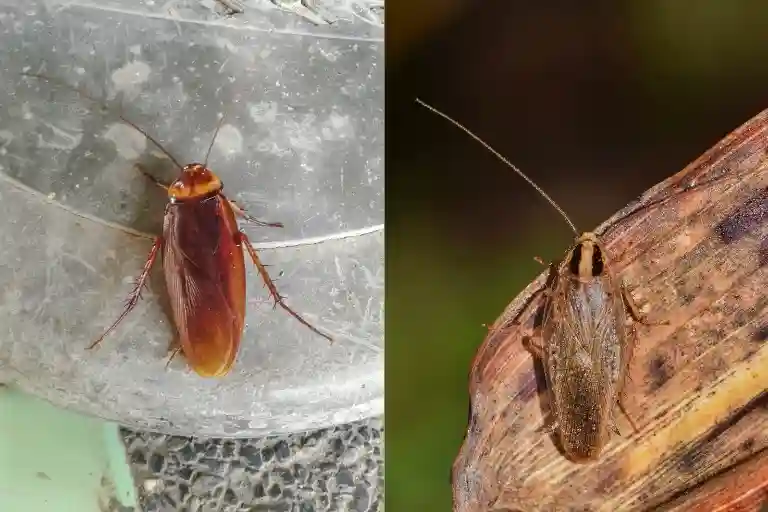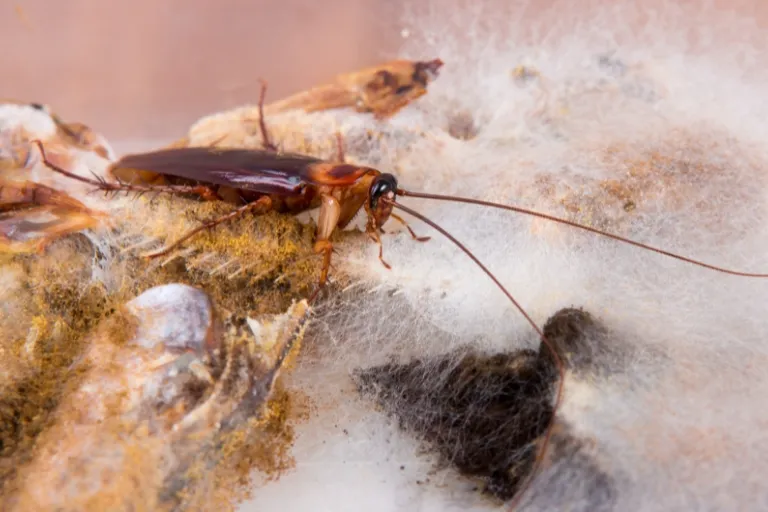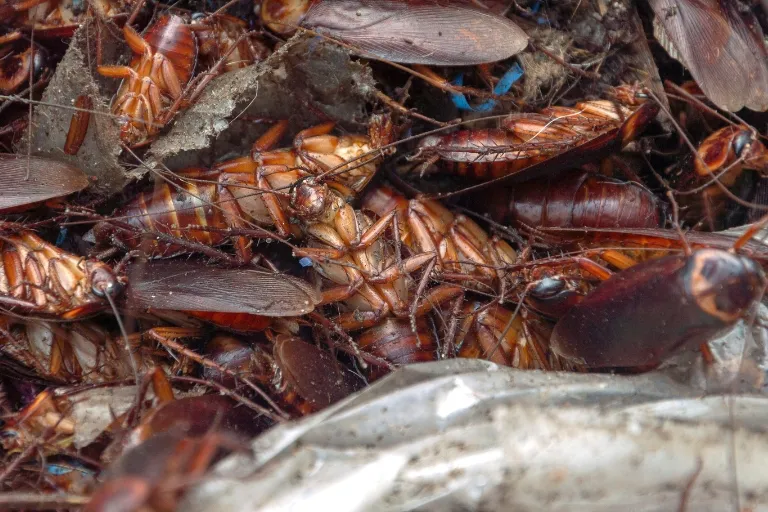German cockroaches are smaller and faster breeders than the larger, less prolific American cockroaches. The German variety prefers indoor habitats, while the American cockroach is more commonly found in moist outdoor environments.
Understanding the differences between German and American cockroaches is crucial for effective pest control.
German cockroaches, with their light brown color and two dark stripes behind the head, usually measure around 13 to 16 mm. They thrive in warm, humid conditions such as kitchens and bathrooms.
In contrast, American cockroaches are reddish-brown, about 35 to 40 mm long, and tend to inhabit basements, sewers, and drains.
They can survive in a wider range of environments, including outdoors. Identifying the type of cockroach infestation is the first step toward finding the right extermination approach.
Quick identification and action can prevent these pests from becoming a long-term problem in your home or business.

Introduction To The World Of Cockroaches
Unseen but ever-present, cockroaches have scuttled through the annals of time, living alongside human civilizations as unwelcome neighbors.
German cockroaches and American cockroaches are two species that make themselves at home in human habitats, sparking debate and discomfort.
As we crack open the door to the resilient world of these pests, let’s explore what sets these creatures apart and why understanding them is crucial for effective pest control.
Defining Pests: An Overview
In the realm of home and health, the term ‘pest’ embodies any creature that invades and disrupts our daily lives.
Cockroaches, notorious for their voracious appetites and rapid reproduction, are high-ranking culprits in this category.
- Health Risks: Cockroaches can spread illnesses, contaminate food, and precipitate allergies.
- Property Damage: Their relentless foraging can damage possessions and interiors.
- Social Discomfort: A cockroach infestation often leads to stress and embarrassment.
Cockroaches: Resilient Survivors Through Time
Through the lens of time, cockroaches have proven themselves remarkable survivors.
These insects have endured for millions of years, adapting and evolving to overcome challenges that have extinguished countless other species.
| Attribute | Description |
|---|---|
| Adaptability | Their ability to thrive in diverse environments underscores their resilience. |
| Reproductive Capacity | High reproduction rates facilitate their survival and spread. |
| Omnivorous Diet | They consume anything organic, granting them versatility in sustenance. |
With such persistence, it’s no surprise they’ve become synonymous with the challenge of eradication.
In comparing German and American cockroaches, their unique traits and behaviors underscore the need for tailored strategies in pest management.
German Cockroach: An Unwelcome Inhabitant
The German cockroach is a prevalent pest around the world and is particularly despised in domestic settings.
Its small size, rapid reproduction rate, and adaptability make it a persistent problem once it invades our living spaces.
Understanding the German cockroach is essential for effective control and creating a cockroach-free environment.
Appearance And Identification
The German cockroach, Blattella germanica, is recognizable by its small and flat body, which measures about half an inch to five-eighths of an inch in length.
The pronotum, a shield-like structure behind its head, carries two distinctive parallel stripes running from head to base.
Adults boast a light brown to tan coloration while the nymphs are darker, often with a darker head and lighter posterior.
Habitat And Survival Strategies
A master of adaptation, the German cockroach thrives in environments where humans dwell.
It prefers warm, humid areas close to food and water sources, which makes kitchens and bathrooms its ideal haunts.
This pest is nocturnal and elusive, using the cover of darkness to scavenge.
Its small size allows it to slip into tiny cracks and crevices, often going unnoticed while it establishes a foothold in your home.
Reproduction And Lifespan
German cockroaches reproduce at an alarming rate, with females capable of producing multiple egg capsules, each containing up to 48 eggs.
They have a short gestation period of about a month, which means populations can skyrocket within weeks.
Their lifespan can extend up to a year, compounding the problem as multiple generations may exist simultaneously.
Common Problems Associated With German Cockroaches
- Allergen Exposure: German cockroaches contribute to indoor allergens, aggravating asthma and allergy symptoms.
- Disease Spread: Known as mechanical disease vectors, these roaches can carry harmful pathogens on their bodies, potentially spreading diseases such as E. coli and Salmonella.
- Property Damage: Infestations can lead to staining and damage to surfaces and belongings due to waste products.
- Persistent Odor: Large populations produce a distinct, unpleasant odor that permeates areas of infestation.
Control Measures And Prevention
Combating German cockroach infestations starts with rigorous sanitation.
Eliminate food and water sources by:
- Keeping kitchens and bathrooms meticulously clean.
- Sealing food in airtight containers and disposing of garbage regularly.
- Fixing leaks and reducing humidity with dehumidifiers or fans.
Additionally, sealing entry points like cracks and crevices deprives cockroaches of their hiding places.
For established infestations, baits, insect growth regulators (IGRs), and residual insecticides applied by professionals prove effective.
Preventive measures that include regular cleaning, proper food storage, and exclusion techniques remain the best defense against this unwelcome inhabitant.
American Cockroach: The Reddish-brown Invader
Spotting an American cockroach in your dwelling is more than an inconvenience; it’s a call to action against one of the most notorious household pests.
Known scientifically as Periplaneta americana, this pest is not only a nuisance but also a health concern.
Let’s delve into the world of the reddish-brown invader and uncover what makes the American cockroach a formidable foe in our homes.

Distinctive Features And Size
The American cockroach showcases a set of distinctive features that make identification relatively straightforward.
This species sports a reddish-brown hue with a glossy body. Adults can be recognized by a yellowish figure-eight pattern on the back of their heads.
Regarding size, they are among the largest of the common cockroaches, with bodies ranging up to 3 inches in length.
Their size alone can be quite alarming to unsuspecting homeowners.
Preferred Environments And Behavioral Traits
American cockroaches thrive in warm, moist environments. They are often found in basements, sewers, and drains, making urban settings with aging infrastructure ideal for their habitation.
These nocturnal creatures are quick runners and can travel from one area to another, spreading contaminants along the way.
- Seeks out warm and humid climates
- Frequent sewers, drains, and basements
- Displays nocturnal behavior and is a rapid runner
Growth And Reproductive Cycle
The reproductive cycle of the American cockroach is impressively efficient, which contributes to their widespread presence.
A single female can produce up to 150 offspring per year. With this high reproductive rate, infestations can escalate quickly if not addressed.
An American cockroach goes through three developmental stages: egg, nymph, and adult.
The entire process can span anywhere from 5 to 15 months, largely depending on environmental conditions.
Health Risk And Nuisance Factor
Beyond being an unwelcome sight, American cockroaches can pose serious health risks.
They can spread bacteria and parasites that may lead to diseases such as salmonella and gastroenteritis.
Additionally, their droppings can become airborne and exacerbate asthma and allergies, particularly in children.
From their sturdy exoskeleton to their rather intimidating size, American roaches can be quite the nuisance, affecting the comfort and well-being of inhabitants in an infested area.
Eradication Techniques
Effective eradication techniques for American cockroaches involve a combination of sanitation, exclusion, and chemical treatments.
Reducing food and water sources, sealing cracks and crevices, and ensuring proper drainage are practical first steps to deter these pests.
For chemical treatments, baits, insecticidal dusts, and residual sprays are commonly employed.
However, due to their health implications, it is often recommended to seek professional pest control services to handle severe infestations.
- Enhance sanitation efforts and reduce resources
- Seal entry points to prevent access
- Implement baits, dusts, and sprays for chemical control
- Consider professional pest management for significant issues
Comparative Analysis: German Vs American Cockroach
When it comes to household pests, few creatures evoke the shudder of disgust that cockroaches do.
Enter the German and the American cockroach two of the most common and unwelcome insect guests.
Despite sharing a name and an uncanny ability to survive in various environments, these species have distinctive characteristics and behaviors that set them apart.
Dive into this comparative analysis to understand the stark contrasts between the German cockroach and the American cockroach.
Size, coloration, and characteristics are easily distinguishable between the German and American cockroaches:
| Feature | German Cockroach | American Cockroach |
|---|---|---|
| Size (Length) | About 13-16 mm | About 35-40 mm |
| Color | Light brown to tan | Reddish-brown |
| Distinguishing Marks | Two dark longitudinal stripes on pronotum | A light-rimmed pattern on pronotum |
| Wings | Fully developed in adults | Fully developed in adults, longer, and more robust |
While both species are notorious for invading human habitations, they have their distinct preferences:
- German Cockroach: Prefers warm and humid environments found within buildings, particularly kitchens and bathrooms.
- American Cockroach: Opts for warm areas but can also thrive in damp, cooler spaces such as basements and drains.
Their reproductive habits exemplify the German and American cockroaches’ starkly different approaches to survival:
- German Cockroach: Boasts a higher reproductive rate, with females producing more eggs per capsule and having more capsules over their lifetime.
- American Cockroach: Produces fewer eggs per capsule but compensates with a longer lifespan, giving numerous opportunities to reproduce.
The health risks posed by these pests are significant, as they are vectors for various pathogens:
- German Cockroach: Can spread bacteria, parasitic worms, and other pathogens due to its preference for residential kitchens.
- American Cockroach: Also a carrier of disease-causing organisms, and its larger size means it can transport more contaminants into the environment.
Effective pest management varies significantly between the two species, presenting unique challenges:
- German Cockroach: More challenging to control because of its rapid reproductive rate and the development of resistance to insecticides.
- American Cockroaches: While still difficult to eradicate, their less frequent reproduction and larger size make them slightly easier to control with bait and traps.
Coping With Cockroach Infestations
Whether scuttling quickly across your kitchen floor or hiding in dark crevices, cockroaches are unwelcome visitors to any home.
The German cockroach and the American cockroach are two of the most common household pests causing dismay.
Confronting cockroach infestations can be a daunting prospect, but understanding the enemy is the first step in reclaiming your space.

Integrated Pest Management Strategies
Integrated Pest Management (IPM) promotes a well-rounded approach to pest control.
This strategic method goes beyond the mere application of pesticides to include a combination of practices aimed at creating hostile environments for pests.
IPM is holistic, considering sanitation, habitat modification, and education to prevent infestations effectively.
- Inspection: Regularly check for signs of cockroach activity, such as droppings or egg cases.
- Sanitation: Maintain a clean home by disposing of garbage promptly and properly storing food.
- Exclusion: Seal cracks and crevices to eliminate entry points for cockroaches.
- Mechanical control: Utilize traps to monitor and reduce cockroach population.
Professional Versus Diy Approaches To Cockroach Control
Deciding between professional and DIY methods for cockroach control is key to managing infestations effectively.
DIY options may be initially less expensive and seem straightforward, but they can lack the potency and staying power of professional treatments.
For a long-term solution, especially in the case of severe infestations, professional exterminators offer customized strategies that reach where DIY efforts cannot.
| DIY Control | Professional Control |
|---|---|
| Over-the-counter spraysBaits and trapsHome remedies | Assessment and tailored solutions Advanced treatment methods Follow-up inspections |
Future Innovations In Pest Management
As the battle against pests like cockroaches continues to evolve, exciting innovations emerge.
Research into non-toxic methods, pheromone traps, and biological control agents offer a glimmer of hope for more environmentally friendly solutions.
Scientists are working on leveraging insect growth regulators that disrupt the lifecycle of cockroaches and other advancements aimed at improving effectiveness while minimizing impact on humans and the environment.
- Eco-friendly pesticides
- Genetic pest management
- Automated monitoring systems
Coexistence Or Conquest?
The seemingly eternal skirmish between humans, German cockroaches, and American cockroaches pivots on a fulcrum of cohabitation and eradication.
Within our homes and businesses, these notorious pests clash, not just with each other but with human tolerance and pest management strategies.
It’s not merely about one species conquering the other; it’s the intricate dance of survival and dominion that paints the broader picture of pest control.
Summarizing The Battle Of Pests
As we dive deeper into the dynamics between the German and American cockroach, it’s evident that their intraspecies rivalry is as intense as their shared defiance against human interlopers.
Locked in a perpetual cycle, each species employs its distinctive survival tactics.
German cockroaches might bear the crown for rapid reproduction, while American cockroaches boast size and resourcefulness, claiming different domains within our urban jungle.
The Role Of Humans In Cockroach Control
In the grand theater of cockroach control, humans are both playwrights and actors.
Intervention through meticulous hygiene practices, structural maintenance, and the judicious use of pesticides shapes the battleground.
The absence of vigilance is the cockroach’s boon, allowing them to thrive.
Yet, with informed and persistent countermeasures, humans can tilt the scales, reducing these pests to manageable levels or even near-eradication in controlled environments.
Final Thoughts On Managing Cockroach Populations
In contemplating the endgame of our relationship with German and American cockroaches, it’s clear that an equilibrium must be struck.
Complete conquest might be an illusion, as these resilient creatures have walked the earth for millennia.
However, through education, innovation, and resilience, managing cockroach populations to ensure human health and comfort is an achievable aspiration.
We stand on the frontier of coexistence framed by conquest, armed with knowledge and driven by the imperative to protect our habitat.
FAQs Of German Cockroach Vs American Cockroach
Do American Roaches Eat German Roaches?
American cockroaches do not typically eat German cockroaches. Instead, they both compete for food and habitat in overlapping environments.
Why Would I Have German Cockroaches?
German cockroaches often infest homes due to easy access to food, water, and shelter. Poor sanitation and clutter can attract them and facilitate their reproduction.
Can German Cockroaches Be Exterminated?
Yes, German cockroaches can be exterminated using professional pest control services, proper sanitation, and over-the-counter insecticides. Continuous management and monitoring are essential for complete eradication.
Are American Roaches Harmful?
American roaches can spread bacteria and allergens, potentially harming humans by triggering allergies or asthma and contaminating food.
Final Words
Understanding the differences between German and American cockroaches is crucial for effective pest control.
Each species has distinctive habits and removal strategies. Acknowledging these can lead to a pest-free environment.
Keep these insights in mind for a targeted approach against these unwelcome guests.
Remember, the right knowledge is your best defense.
Resources:
1. https://www.ncbi.nlm.nih.gov/pmc/articles/PMC4032040/
2. https://acsd-az.gov/cockroaches/
